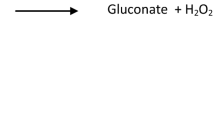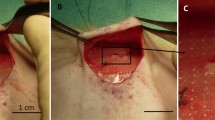Abstract
Background:
The use of alloplastic materials such as polypropylene and polyester has reduced the recurrence of abdominal wall hernias. Concomitantly, new problems have arisen such as inflammatory response against the implanted material and the development of enteric fistulas in case of direct contact of the bowel to polypropylene and polyester. A precoating of the PP with collagen and other absorbable materials seems to reduce the incidence of adhesions and fistulas. The aim of this study was to show the technical feasibility of a precoating of polypropylene with living human fibroblasts and to investigate the growth properties of the cells under these conditions in vitro.
Methods
The textile structure of three different alloplastic materials is described (SurgiPro®, TycoHealthcare; Parietene3 PP1510®, Dallhausen; VIPRO II®, Ethicon Endosurgery). Enhanced Green Fluorescence Protein (EGFP) transduced human foreskin fibroblasts (KiF5) were seeded onto these different alloplastic materials. Proliferation was analyzed by FACS analysis of Ki67 expression. The coating process of the whole mesh area was observed over time with UV-light microscopy, immunostaining, and scanning electron microscopy (SEM). The expression of collagen type I and III was investigated by immunostaining.
Results
The three alloplastic materials used were knitted fabrics with different textile structures. KiF5 colonized the entire alloplastic material within 4–6 weeks. Cells were proliferating, as detected by Ki67 expression. SEM showed surface ruffles and long cellular extensions, indicating an active cell metabolism. Light microscopy and SEM suggested that the cells modify the apolar surface by deposition of extracellular matrix components before colonization.
Conclusion
Our study shows the feasibility of precoating of polypropylene meshes with living human fibroblasts and opens the possibility for clinical use in the future.



Similar content being viewed by others
References
A Akoum Y Marois R Roy M King R Guidoin M Sigot MF Sigot-Luizard (1992) ArticleTitleUse of myxalin for improving vascular graft healing: evaluation of biocompatibility in rats J Invest Surg 5 129–141 Occurrence Handle1610738
ML Baptista ME Bonsack JP Delaney (2000) ArticleTitleSeprafilm reduces adhesions to polypropylene mesh Surgery 128 86–92 Occurrence Handle10.1067/msy.2000.106810 Occurrence Handle10876190
JM Bellon A Garcia-Carranza N Garcia-Honduvilla A Carrera-San Martin J Bujan (2004) ArticleTitleTissue integration and biomechanical behaviour of contaminated experimental polypropylene and expanded polytetrafluoroethylene implants Br J Surg 91 489–494 Occurrence Handle10.1002/bjs.4451 Occurrence Handle15048754
H Brem J Young M Tomic-Canic C Isaacs HP Ehrlich (2003) ArticleTitleClinical efficacy and mechanism of bilayered living human skin equivalent (HSE) in treatment of diabetic foot ulcers Surg Technol Int 11 23–31 Occurrence Handle12931279
Broll R, Bethge T, Windhovel U, Schwandner O, Markert U, Bruch HP, Duchrow M (2002) Influence of resterilized polypropylen meshes on growth of human fibroblasts- an experimental in vitro study. Zentralbl Chir 127
CE Butler FA Navarro DP Orgill (2001) ArticleTitleReduction of abdominal adhesions using composite collagen-GAG implants for ventral hernia repair J Biomed . Mater Res 58 75–80 Occurrence Handle10.1002/1097-4636(2001)58:1<75::AID-JBM110>3.0.CO;2-J Occurrence Handle11153001
MA Carbajo JC Martin Olmo Particledel JI Blanco C la Cuesta Particlede M Toledano F Martin C Vaquero L Inglada (1999) ArticleTitleLaparoscopic treatment vs open surgery in the solution of major incisional and abdominal wall hernias with mesh Surg Endosc 13 250–252 Occurrence Handle10.1007/s004649900956 Occurrence Handle10064757
A Coda R Bendavid F Botto-Micca M Bossotti A Bona (2003) ArticleTitleStructural alterations of prosthetic meshes in humans Hernia 7 29–34 Occurrence Handle12612795
M Duchrow U Windhovel T Bethge O Schwandner U Markert HP Bruch R Broll (2002) ArticleTitle[Polypropylene synthetic mesh modifies growth of human cells in vitro. An experimental study] Chirurg 73 154–158 Occurrence Handle10.1007/s00104-001-0375-3 Occurrence Handle11974479
E Endl P Steinbach R Knuchel F Hofstadter (1997) ArticleTitleAnalysis of cell cycle-related Ki-67 and p120 expression by flow cytometric BrdUrd-Hoechst/7AAD and immunolabeling technique Cytometry 29 233–241 Occurrence Handle10.1002/(SICI)1097-0320(19971101)29:3<233::AID-CYTO6>3.0.CO;2-C Occurrence Handle9389440
I Felemovicius ME Bonsack G Hagerman JP Delaney (2004) ArticleTitlePrevention of adhesions to polypropylene mesh J Am Coll Surg 198 543–548 Occurrence Handle10.1016/j.jamcollsurg.2003.12.004 Occurrence Handle15051006
K Junge U Klinge B Klosterhalfen PR Mertens R Rosch A Schachtrupp F Ulmer V Schumpelick (2002) ArticleTitleInfluence of mesh materials on collagen deposition in a rat model J Invest Surg 15 319–328 Occurrence Handle10.1080/08941930290086137 Occurrence Handle12542866
S Kyzer A Kadouri A Levi E Ramadan H Levinsky M Halpern C Chaimoff (1997) ArticleTitleRepair of fascia with polyglycolic acid mesh cultured with fibroblasts—experimental study Eur Surg Res 29 84–92 Occurrence Handle9058075
GE Leber JL Garb AI Alexander WP Reed (1998) ArticleTitleLong-term complications associated with prosthetic repair of incisional hernias Arch Surg 133 378–382 Occurrence Handle10.1001/archsurg.133.4.378 Occurrence Handle9565117
A Limat LE French L Blal JH Saurat T Hunziker D Salomon (2003) ArticleTitleOrganotypic cultures of autologous hair follicle keratinocytes for the treatment of recurrent leg ulcers J Am Acad Dermatol 48 207–214 Occurrence Handle10.1067/mjd.2003.69 Occurrence Handle12582390
RW Luijendijk WC Hop MP Tol Particlevan den DC Lange Particlede MM Braaksma J J.N. RU Boelhouwer BC Vries Particlede MK Salu JC Wereldsma CM Bruijninckx J Jeekel (2000) ArticleTitleA comparison of suture repair with mesh repair for incisional hernia N Engl J Med 343 392–398 Occurrence Handle10.1056/NEJM200008103430603 Occurrence Handle10933738
CJ Morgan C Jacques F Savagner Y Tourmen DP Mirebeau Y Malthiery P Reynier (2001) ArticleTitleA conserved N-terminal sequence targets human DAP3 to mitochondria Biochem Biophys Res Commun 280 177–181 Occurrence Handle10.1006/bbrc.2000.4119 Occurrence Handle11162496
O Ohtani (1987) ArticleTitleThree dimensional organization of the connective tissue fibres of the human pancreas: a scanning electron microscopic study of NaOH treated tissues Arch Histol Japon 50 557–566
A Park DW Birch P Lovrics (1998) ArticleTitleLaparoscopic and open incisional hernia repair: a comparison study Surgery 124 816–821 Occurrence Handle10.1067/msy.1998.92102 Occurrence Handle9781006
H Scheidbach C Tamme A Tannapfel H Lippert F Kockerling (2004) ArticleTitleIn vivo studies comparing the biocompatibility of various polypropylene meshes and their handling properties during endoscopic total extraperitoneal (TEP) patchplasty: an experimental study in pigs Surg Endosc 18 211–220 Occurrence Handle10.1007/s00464-003-8113-1 Occurrence Handle14691711
S Stelzner G Hellmich K Ludwig (2004) ArticleTitleRepair of paracolostomy hernias with a prosthetic mesh in the intraperitoneal onlay position: modified Sugarbaker technique Dis Colon Rectum 47 185–191 Occurrence Handle10.1007/s10350-003-0030-9 Occurrence Handle15043288
AK Tausche M Skaria L Bohlen K Liebold J Hafner H Friedlein M Meurer RJ Goedkoop U Wollina D Salomon T Hunziker (2003) ArticleTitleAn autologous epidermal equivalent tissue-engineered from follicular outer root sheath keratinocytes is as effective as split-thickness skin autograft in recalcitrant vascular leg ulcers Wound Repair Regen 11 248–252 Occurrence Handle10.1046/j.1524-475X.2003.11403.x Occurrence Handle12846911
TL Tuan A Song S Chang S Younai ME Nimni (1996) ArticleTitleIn vitro fibroplasia: matrix contraction, cell growth, and collagen production of fibroblasts cultured in fibrin gels Exp Cell Res 223 127–134 Occurrence Handle10.1006/excr.1996.0065 Occurrence Handle8635484
M van’t Riet PJ Vos Steenwijk Particlede van F Bonthuis RL Marquet EW Steyerberg J Jeekel HJ Bonjer (2003) ArticleTitlePrevention of adhesion to prosthetic mesh: comparison of different barriers using an incisional hernia model Ann Surg 237 123–128 Occurrence Handle10.1097/00000658-200301000-00017 Occurrence Handle12496539
M van’t Riet JW Burger F Bonthuis J Jeekel HJ Bonjer (2004) ArticleTitlePrevention of adhesion formation to polypropylene mesh by collagen coating: a randomized controlled study in a rat model of ventral hernia repair Surg Endosc 18 681–685 Occurrence Handle10.1007/s00464-003-9054-4 Occurrence Handle15026899
A Verbo L Petito G Pedretti M Lurati P D’Alba C Coco (2004) ArticleTitleUse of a new type of PTFE mesh in laparoscopic incisional hernia repair: the continuing evolution of technique and surgical expertise Int Surg 89 27–31 Occurrence Handle15085994
B Wulfhorst (1989) ArticleTitlePolypropylene fibres Chemiefaser/Textilindustrie 39 3–11
RM Young R Gustafson RC Dinsmore (2004) ArticleTitleSepramesh vs. Dualmesh for abdominal wall hernia repairs in a rabbit model Curr Surg 61 77–79 Occurrence Handle10.1016/j.cursur.2003.09.011 Occurrence Handle14972176
Acknowledgment
The authors thank Marie-Luise Kruse, PhD, for critical reading of the manuscript and fruitful discussion.
Author information
Authors and Affiliations
Corresponding author
Rights and permissions
About this article
Cite this article
Kapischke, M., Prinz, K., Tepel, J. et al. Precoating of alloplastic materials with living human fibroblasts—a feasibility study. Surg Endosc 19, 791–797 (2005). https://doi.org/10.1007/s00464-004-9222-1
Received:
Accepted:
Published:
Issue Date:
DOI: https://doi.org/10.1007/s00464-004-9222-1




